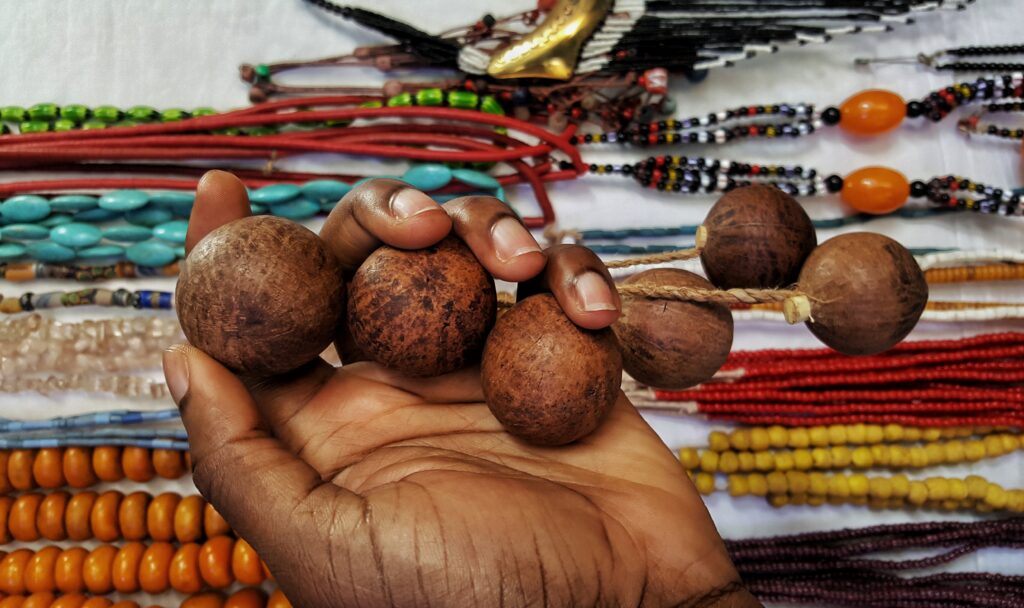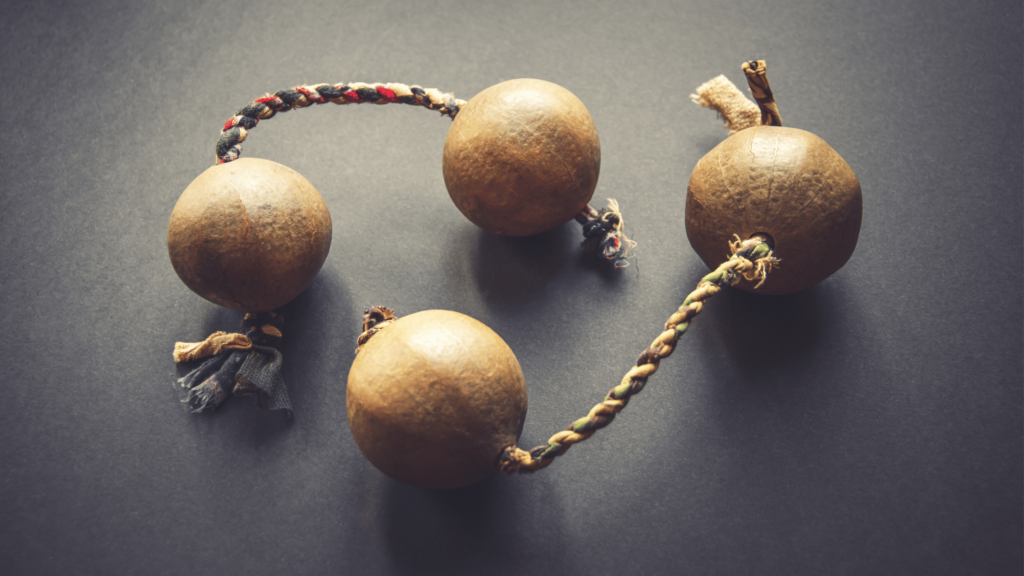The rhythmic pulses of West Africa have birthed a plethora of unique instruments, and among them is the captivating Kashaka.
If you’ve ever felt the urge to explore a musical hobby that’s both fascinating and accessible, look no further.
Kashaka, also known as Asalato, Patica, or Kosika in different regions, is not just an instrument but a testament to the joys of rhythm and motion.
Comprising two small gourds filled with beads or seeds, this seemingly simple instrument has the potential to produce intricate rhythms, making it a perfect entry into the vast world of percussion.
So, if you’re ready to embark on a musical journey that’s as entertaining as it is enriching, let’s dive into the vibrant world of Kashaka!
This article contains affiliate links. If you make a purchase through a link on our site you are supporting our continued efforts to educate people like you in finding new and rewarding hobbies. Thank you!

The Rich History of Kashaka
In the heart of West Africa, where storytelling and rhythm intermingle under the vast skies, Kashaka found its roots. Let’s embark on a journey through time to understand the rich tapestry from which this instrument emerged:
- Origins: Kashaka’s humble beginnings can be traced to several West African countries, notably Ghana, Guinea, and Nigeria. Traditionally crafted by hollowing out small gourds and filling them with seeds or small stones, this instrument was more than just a tool for making music. It was a medium of communication, with its rhythms echoing the heartbeats of its communities.
- Cultural Significance in Traditional African Music: In ceremonies, gatherings, and local festivities, the Kashaka would be played, either as a solo instrument or accompanying other instruments, adding its unique rhythm to the soundscape. It wasn’t just about music; it was about connection, celebration, and a shared understanding of life’s rhythms.
- Global Exposure: The world began to appreciate the magic of Kashaka when African musicians started touring globally. As these rhythms resonated with audiences worldwide, many were intrigued by the instrument’s ability to produce complex patterns with such a simple design. Over time, the Kashaka made its way into percussion ensembles, fusion music genres, and even educational institutions, marking its footprint in the global rhythm community.
The Kashaka’s journey from local West African villages to global stages is a testament to the universality of rhythm. Regardless of language, culture, or geography, the primal beat of Kashaka has shown that music is a language everyone understands.

Understanding the Instrument
Before diving into techniques and rhythms, it’s essential to have a clear understanding of the Kashaka itself. Simple in design, but vast in its rhythmic potential, this instrument is a marvel of African craftsmanship.
- Components: The Kashaka is made up of two small gourds, traditionally hollowed out and dried. These gourds are filled with either beads, seeds, or small pebbles that produce the characteristic sound when shaken. The gourds are connected with a string, which allows the player to swing, shake, and flip them in various rhythmic patterns.
- Variants: Though the basic structure remains consistent, Kashakas can differ in size, material, and even the items used as fillers. Depending on the region or personal preference, a player might choose a Kashaka that’s larger, with a more resonant sound, or smaller, producing sharper, quicker rhythms. Additionally, while traditional Kashakas are made from gourds, modern adaptations might utilize plastic or other materials for durability and consistency in sound.
- Names Across Regions: The beauty of the Kashaka is not only in its sound but also in its multicultural presence. Depending on where you are in West Africa, you might hear it referred to as “Asalato” in parts of Ghana, “Patica” in certain regions of Guinea, or “Kosika” elsewhere. Each name carries with it nuances, stories, and traditions specific to its locality.
In essence, the Kashaka is a blend of nature, craftsmanship, and rhythm. It’s an instrument that, despite its simplicity, requires skill, finesse, and a deep connection to the rhythm to truly master.
As you hold it in your hands, remember that you’re not just holding an instrument – you’re embracing centuries of tradition, stories, and rhythms that have echoed across the African continent.

Basic Techniques to Master Kashaka
Just like learning any new skill, mastering the Kashaka begins with understanding its foundational techniques. While it might appear straightforward, the Kashaka can produce a vast range of rhythms. Let’s break down the basic techniques every beginner should know:
- Hand Positioning: The foundation of playing the Kashaka lies in how you hold it. Grasp one gourd between your thumb and first two fingers, allowing the other gourd to swing freely. The string should rest behind your hand, ready for swinging and flipping actions.
- Basic Rhythms: Begin with simple rhythmic patterns. Start with a steady shake, allowing the beads or seeds inside the gourds to produce a consistent sound. This initial rhythm serves as a base upon which you can layer more complex patterns.
- Swinging: Initiate a swinging motion, allowing the free gourd to swing outward and then back into the palm of your hand. This action will create a distinct rhythmic pattern, different from the shaking sound.
- Shaking: With the Kashaka in your hand, gently shake it from side to side. This will produce a soft, maracas-like sound. Adjusting the intensity of your shake will alter the volume and pace of the rhythm.
- Flipping: Perhaps one of the trickier beginner moves, flipping involves using the fingers to flip the free-swinging gourd over the hand and catching it as it comes around. When done in rhythm, this technique can produce intricate patterns.
The beauty of the Kashaka lies in its versatility. As you get comfortable with these basic techniques, you’ll find that there’s an entire world of rhythm waiting for you. With patience and practice, you’ll soon be producing captivating rhythms that resonate with the soul of West Africa.
Advanced Kashaka Techniques
Once you’ve familiarized yourself with the basics and feel the rhythm flowing naturally through your hands, it’s time to venture into the world of advanced Kashaka techniques. These methods add depth, intricacy, and flair to your performances, turning simple beats into mesmerizing rhythmic compositions.
- Combining Rhythms: The magic often lies in the merger of various basic techniques. Experiment by joining swinging, shaking, and flipping in various sequences. For instance, you can swing the Kashaka, follow it with a flip, and then transition into a shake, creating a unique rhythmic pattern.
- Syncopation: Introduce off-beat rhythms to give your Kashaka play a more dynamic feel. By emphasizing beats that aren’t typically accentuated, you can create unexpected and captivating rhythms. This technique requires a solid understanding of rhythm, making it a fun challenge for those ready to take their skills to the next level.
- Doubles: This involves using two Kashakas simultaneously, one in each hand. It might sound overwhelming, but once mastered, playing doubles can produce rich, layered rhythms that are truly captivating. Start with simple patterns in each hand before experimenting with more complex rhythms.
- Pairing with Other Instruments: While the Kashaka is delightful on its own, it can shine even brighter when paired with other instruments. Whether it’s alongside a djembe drum, a balafon, or even modern instruments like a guitar, the Kashaka can add a unique rhythmic texture to ensemble settings.
- Creating Your Own Patterns: Once you’re confident with the established techniques, why not innovate? Create your own rhythms, merge techniques in unexpected ways, and let your creativity guide your hands. The Kashaka is an instrument of expression, and there’s no limit to the patterns you can produce.
Remember, advanced techniques require patience, dedication, and lots of practice. It’s okay to feel challenged; that’s part of the journey. With every swing, shake, and flip, you’re not just playing an instrument—you’re adding to the rich tapestry of Kashaka rhythms that have been evolving for centuries.
Where to buy a Kashaka?
If you’re looking to buy a Kashaka, (also known as Asalato) there are several places you can explore:
- Local Music Stores: Some specialty music stores, particularly those focusing on world or ethnic instruments, might carry the Kashaka. It’s worth giving a few a call or visiting in person.
- Online Retailers: Websites like Amazon, eBay, and other online marketplaces often have sellers offering Kashakas. Be sure to read the product description and reviews to ensure you’re getting a quality instrument.
- Specialty Online Shops: There are online stores dedicated to percussion and ethnic instruments that might carry Kashakas. Websites like X8 Drums, Djembe Direct, or African Drumming might have them in stock.

Benefits of Playing Kashaka
Beyond the captivating rhythms and the joy of mastering a new instrument, playing the Kashaka offers a range of benefits that touch both the mind and body. Here’s why adding the Kashaka to your repertoire can be both fun and beneficial:
- Mind and Body Coordination: The intricate movements required to produce rhythms with the Kashaka naturally enhance hand-eye coordination and dexterity. As you progress, you’ll notice your movements becoming more fluid and synchronized.
- Cognitive Skills: Learning and remembering rhythmic patterns stimulate memory and concentration. The challenge of mastering new patterns keeps the mind active and engaged.
- Stress Relief: Music, especially rhythm, has therapeutic qualities. The repetitive actions and sounds of the Kashaka can be meditative, helping to calm the mind and reduce stress. Whether you’re playing slow, soothing patterns or fast-paced beats, the act of engaging with the instrument can serve as a mindful escape.
- Cultural Appreciation: Engaging with the Kashaka provides a deeper understanding and appreciation of West African musical traditions. As you learn, you become more connected to a rich cultural tapestry that extends beyond borders and generations.
- Social Engagement: Playing the Kashaka can be a communal experience. Joining groups or participating in ensemble settings encourages social interaction, teamwork, and shared musical experiences.
- Physical Exercise: While it might not seem like a workout, extended Kashaka playing sessions can indeed give your arms and upper body a light exercise, improving stamina over time.
- Boosts Creativity: As you delve deeper into creating your own rhythms and patterns, the Kashaka becomes an outlet for creative expression. It’s not just about replicating traditional beats but also about innovating and expressing your unique musical voice.
Embracing the Kashaka is more than just picking up a new hobby. It’s a holistic experience that offers personal growth, relaxation, and a connection to a vibrant musical heritage. Whether you’re playing for personal pleasure or sharing the rhythm with others, the benefits of the Kashaka are both profound and enriching.

Conclusion: Embrace the Joy of Kashaka
As we conclude our exploration of the Kashaka, it’s clear that this isn’t just an instrument—it’s a world of rhythm, culture, and community. From the simple swing of its gourds to the intricate patterns that can be produced, the Kashaka embodies the essence of musical expression.
Embarking on the Kashaka journey is about more than learning a new skill. It’s about connecting with centuries-old traditions, understanding the nuances of rhythm, and finding joy in each swing, shake, and flip. Every time you play, you are tapping into a rhythm that has been shared, cherished, and passed down through generations.
Moreover, as a hobby, Kashaka offers a plethora of benefits. It’s not just about the music but also about the personal growth, cognitive enhancement, and sheer joy it brings. The community around it further enriches the experience, making every player part of a larger, rhythm-loving family.
So, if you’re on the fence about diving into the world of Kashaka, remember this: every master was once a beginner. With patience, dedication, and passion, the Kashaka can become more than just a hobby—it can become a way of life, a rhythmic heartbeat that resonates with the soul.
Whether you’re playing solo, jamming with friends, or sharing the rhythm with a community, let the Kashaka guide you on a musical journey like no other. Dive in, embrace the rhythm, and let the Kashaka’s timeless beats carry you away!

